Steemit Crypto Academy /Season 3 / week 6 - Homework post for Professor @pelon53
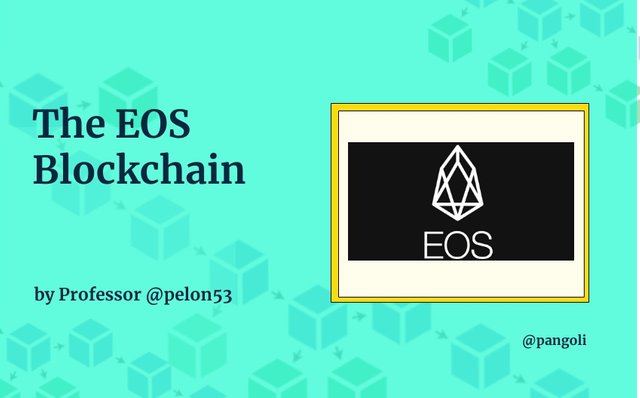
My own work
Hey guys...
I believe you're as excited as I am to have taken part in this week's lecture on the EOS Blockchain with professor @pelon53. Indeed, a lot has been taught and learnt at the same time. Sequel to the classroom experience, I have my entry for the homework task detailed below.
Introduction
All blockchains follow a consensus Algorithm in the process of mining and adding new blocks to the blockchain. Consensus algorithms have greatly evolved over time, starting from Bitcoin's Proof of Work (POW), to the many other variants that are present today.
Most of the emerging consensus algorithms are basically framed with improvements inspired by the weaknesses observed in other blockchains. These improvements are made with intentions of making the blockchain process more user-friendly than has ever been.
The Proof of Stake (POS) consensus algorithm got developed to fill the scalability and energy consumption gap witnessed in Bitcoin's Proof of Work (PoW). The game of improvement has been on since then, with more and more variants of consensus algorithms being churned out by the day. In the same vein, an improvement on the Proof of Stake (PoS) consensus algorithm emerged with the name, Delegated Proof of Stake (DPoS). The DPoS developed by Daniel Larimer, the founder of the EOS blockchain.
Q1: Explain the Delegated Proof of Stake, DPoS algorithm
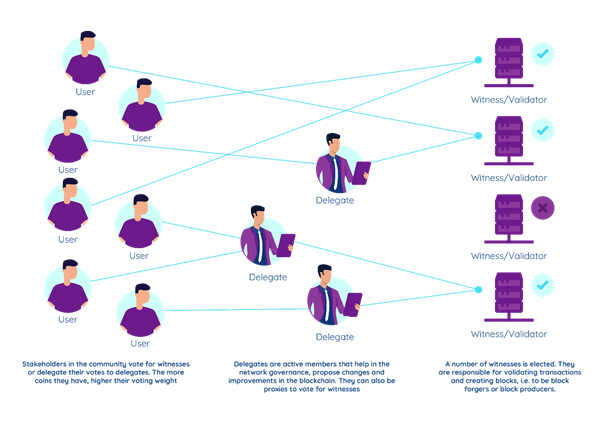
Image source
Delegated proof-of-stake (DPoS) is a consensus algorithm that was developed to give more power to the users of a blockchain, to enable them transfer authority to selected members, who will take on the role of maintaining and securing the blockchain through creation and validation of blocks.
As I had earlier mentioned, DPoS was developed to improve upon the Proof of Stake (PoS), and by extension, Proof of Work consensus algorithms. A bulk of the issues that plagued the first two consensus variants rallied around scalability and transaction cost. The DPoS consensus algorithm introduced an alternative feature that further encouraged decentralization.
DPoS based Blockchains process transactions much faster and cheaper than most other forms of blockchain consensus. A typical DPoS Blockchain follows a process where users select those who will make decisions about the blockchain on their behalf. Just like representative, those selected are called “witnesses.” This selection happens through a voting process, where users (delegates) willingly allocate their share of a blockchain’s governance token to a member (Witness) of their choice, thereby increasing this witness’ voting power.
With the increased voting power, these witnesses get to validate blocks on the blockchain, as well as offer their votes for or against changes proposed for the blockchain’s protocol. This form of blockchain consensus has its strengths and weaknesses, which are explored as follows:
| Strengths | Weaknesses |
|---|---|
| 1. It is very scalable | Because witnesses are in control of the network, a 515 attack can be easily achieved |
| 2. There are many powerful witnesses to actively contribute to the Blockchain | The witness nodes decide the growth trajectory of the blockchain with how they function |
| 3. Users participate in electing witnesses | witnesses can lobby users with high voting power to delegate to them |
Q2: Explain What are Ricardian contracts on the EOS Blockchain?
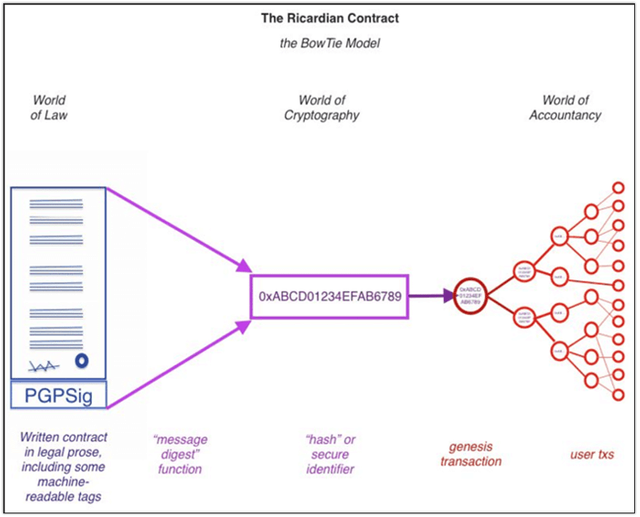
Image source
The Ricardian Contract was created in 1995 by Ian Grigg. As a popular programmer, Ian Grigg introduced the contract as a digitally embellished legal document, expressing the terms binding an agreement between the parties involved.
The unique feature of this contract is that the legal document is secured by a cryptographic hash from the digital signatures of the parties involved. In essence, this document is rendered in a way that makes it readable by both humans – In the legal profession or not – and machines. With blockchain platforms, this digital contract document is hashed, signed and saved.
The Ricardian contract model merges blockchain technology with Legal contracts in a unique way that binds parties in a legal contract, before executing the agreement on a blockchain.
Ricardian Contracts And The EOS Blockchain
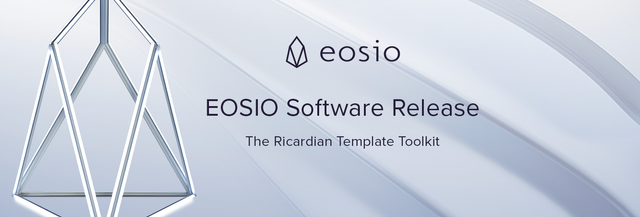
Image source
The whole essence of Ricardian contracts on the EOS blockchain is to promote inclusiveness by cultivating understanding. That is, a situation where users are well aware of the terms behind every contract they sign.
The bane of most Smart contracts prior to the advent of Ricardian contracts was their technicality. They were only meaningful to those who were conversant with the technical jargons embedded in them; hence, users never had a rounded understanding of what they are authorizing these smart contracts to do. It is under this guise that malicious attacks like phishing and switch, which trick users to take actions to their own disadvantage.
To this effect, EOSIO’s major move has been to define a Ricardian contract around its Smart contracts to serve as the client’s side explainer of the complex smart contract syntax. The Ricardian Contract Specification has been a key recommendation for EOS developers, to be applied in Smart Contract development.
Q3: Explore the official EOSREX interface (eosauthority.com). Show screenshots
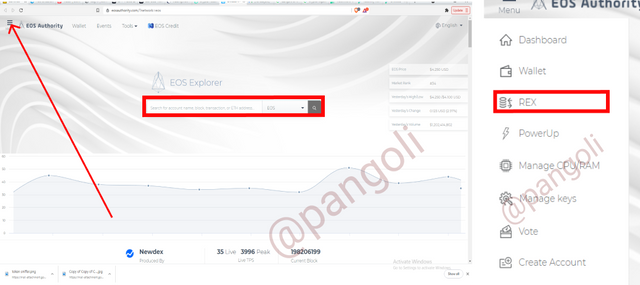
Image source
The EOSREX interface is a section of the EOS platform that displays key information and connection between the EOS and REX token. To land on the EOSREX interface, you navigate to the menu icon on the top left of the eosauthority.com landing page. Once the menu Icon is clicked, a menu appears with one of its items labelled "REX." Click on it.
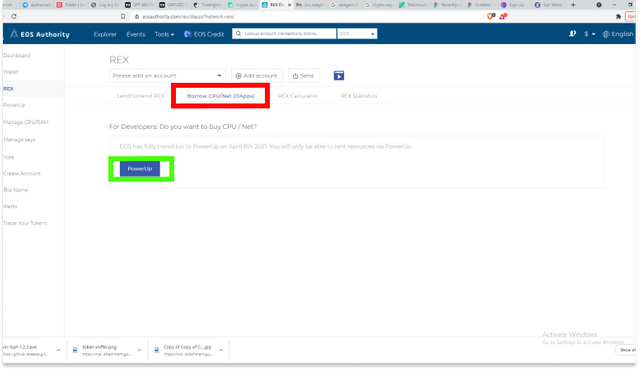
Image source
In the REX section, there are sub-categories like:
- Borrow CPU/Net (Dapps)
- REX calculator
- REX statistics
As shown on the screenshot above, the "Borrow CPU/ Net (Dapps)" segment has the option to "power up." This is where connected nodes can increase their voting power.
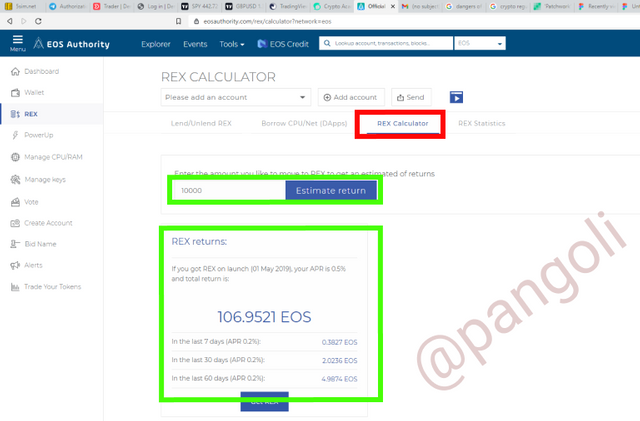
Image source
In the REX calculator segment, users can calculate and estimate the returns on the REX token holdings.
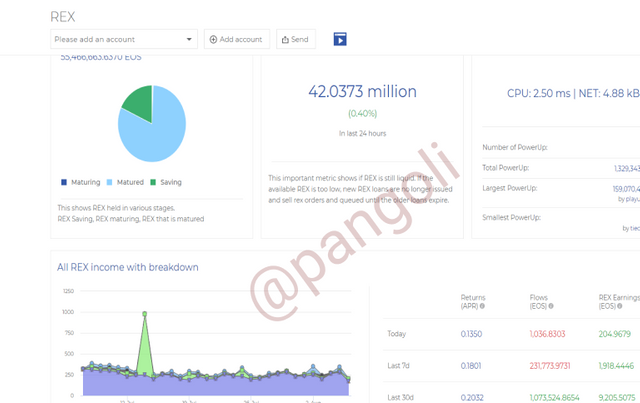
Image source
REX statistics capture some analytics report on on the REX token. It displays results on matrices like Network Income, total Rex holdings, total volume transacted in a 24-hour period, and other relevant matrices based on a concrete data analytics on the REX token.
Q4: Download the Sqrl wallet, explore and explain how to obtain CPU, RAM and Network. Show screenshot.
Before I proceed, there are a few facts to state:
- SQRL is the wallet built on the EOS blockchain, hence, it is interoperable with the Telos platform.
- Oftentimes, creating an account through the sqrl wallet directly poses some challenges and triggers error messages. Hence, I will first create my wallet keys via Telos, then import it to sqrl.
Step 1
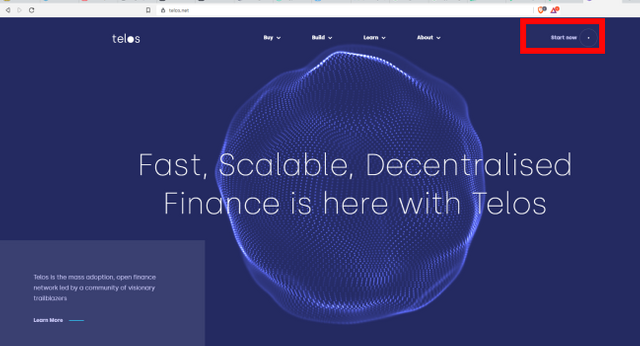
Image source
To have access to the Telos wallet, log in with https://telos.net
Click on the "Start new" button on your top right screen
Step 2
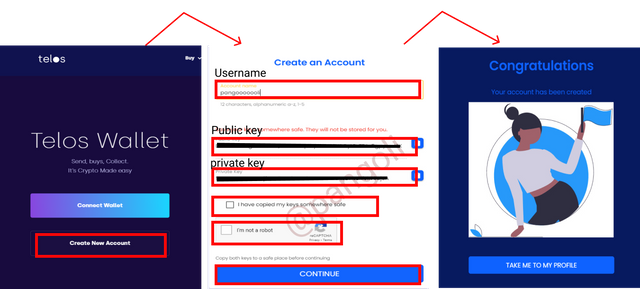
Image source
Click on "Create New Wallet" and fill out the form that follows with preferred account name, then click "Continue."
Remember to copy the keys before proceeding.
Now, your Account has been successfully created.
Now, I will launch my Sqrl wallet and proceed with wallet configuration using the created login.
Step 3.
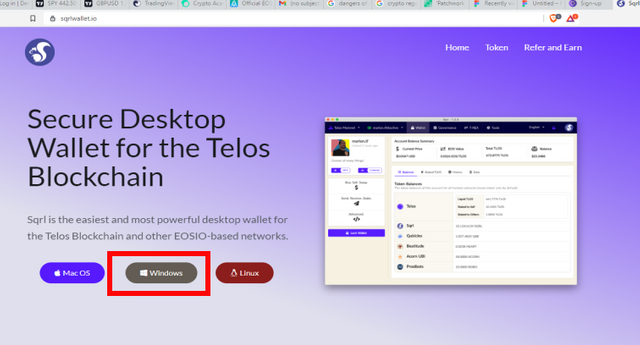
Image source
Go To httpts://sqrlwallet.io and install the wallet that fits your device specification. I installed the windows version as shown in the screenshot.
Once installation is done and the app is launched. Proceed to the next step.
Step 4

Image source
- Click on "Import Existing Account" (using the keys from the account created on Telos) and Enter "Public key or account name," then click "LOOKUP."
- Select your Account Name from the options and click "SELECT ACCOUNT." ( I used the name "usenjamesss" for my demo account set up as can be seen on the screenshot).
You will be required to enter your Private Key.
Step 5
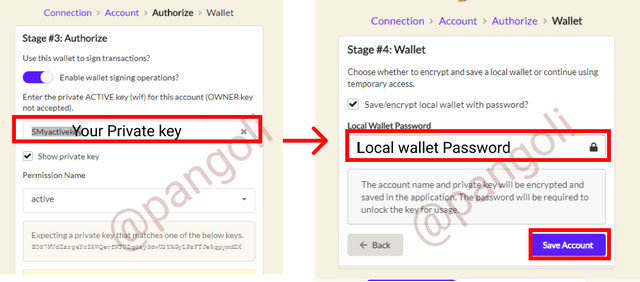
Image source
Enter your keys as well as a Local Wallet Password. Confirm password and proceed. Viola! Your Sqrl account has been fully set up
Exploring the Sqrl Wallet
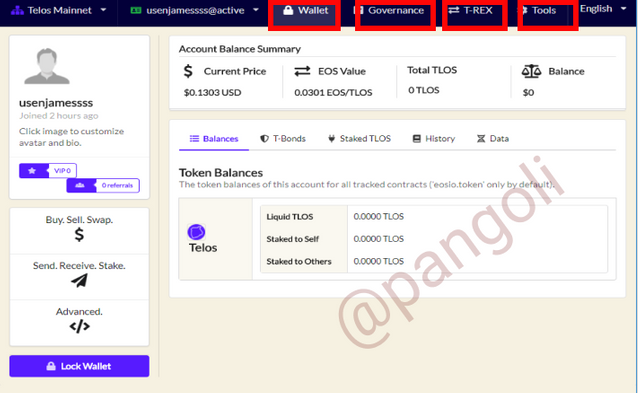
Image source
On the landing page there is a navigation bar with the labels:
-Wallet
- Governance
- T_REX
- Tool
Let us take some time to explore each of these segments.
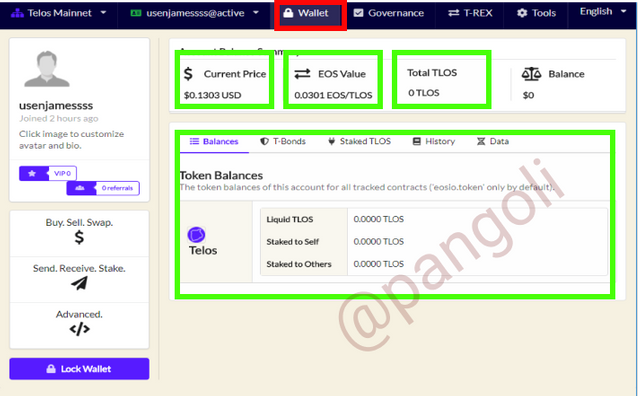
Image source
In the Wallet segment, which also is the display of the
landing page, there is a summary of the wallet details. Which include: Current price if TLOS in USD, Current value of TLOS in EOS, Total amount of TLOS held by the user, and other relevant asset information.
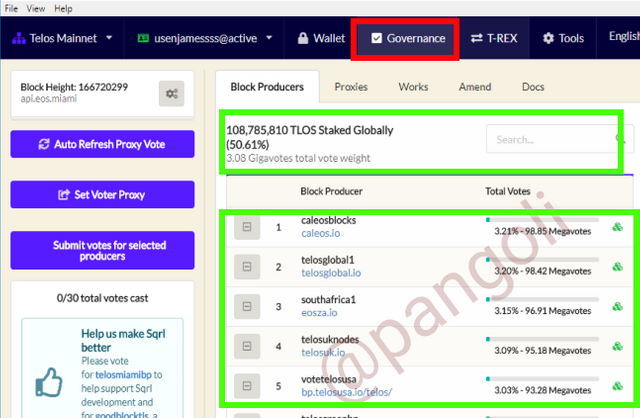
Image source
The Governance segment displays details on Block producers (otherwise called Witnesses) and their total votes measured in Megavotes. Also, the total value of TLOS staked globally is displayed in this window and it sits at a total of 108,785,810 TLSOs.
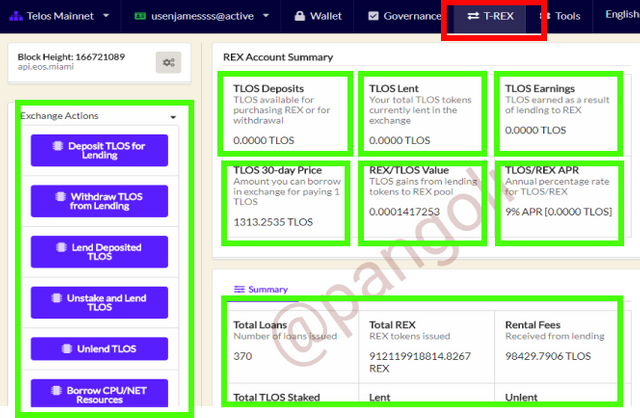
Image source
The T-REX segment gives us the REX account summary, with information on key project matrices like deposits to lending pools, withdrawals from lending pools, earnings, Annual Percentage Rates (APR), rental fees, etc.
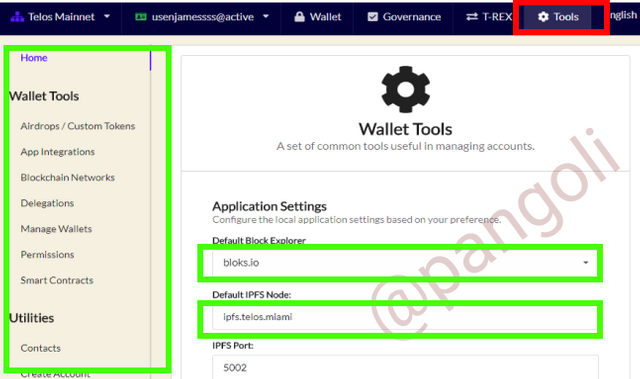
Image source
The tools segment consists of the different tools that can be utilized in accounts management. It contains the information that link to the block explorer, default IPFS nodes, etc.
To obtain CPU/ Network RAM
CPU
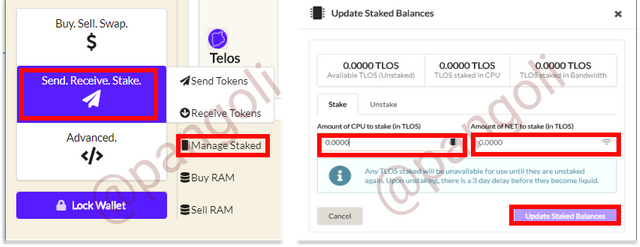
Image source
To obtain CPU, follow the steps below:
- Go to the wallet tab
- Click on the Send/Receive stake option (as shown on the screenshot)
- Click on the Manage Stake option
Once the purchase window is displayed. Enter the amount of assets to be staked for Processing power in the network, then click on Update Staked balances.
Network RAM
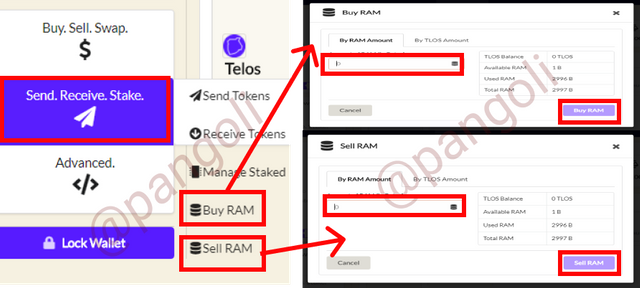
Image source
To Buy/Sell Network RAM, follow the steps below:
- Go to the wallet tab
- Click on the Send/Receive/ stake option
- Depending on the desired transaction, Click on either BUY/SELL RAM options
- Once the purchase window opens, choose the Amount of RAM in bytes and click on Buy or Sell RAM
Q5 : Show the price of the REX token. And explain what it is used for
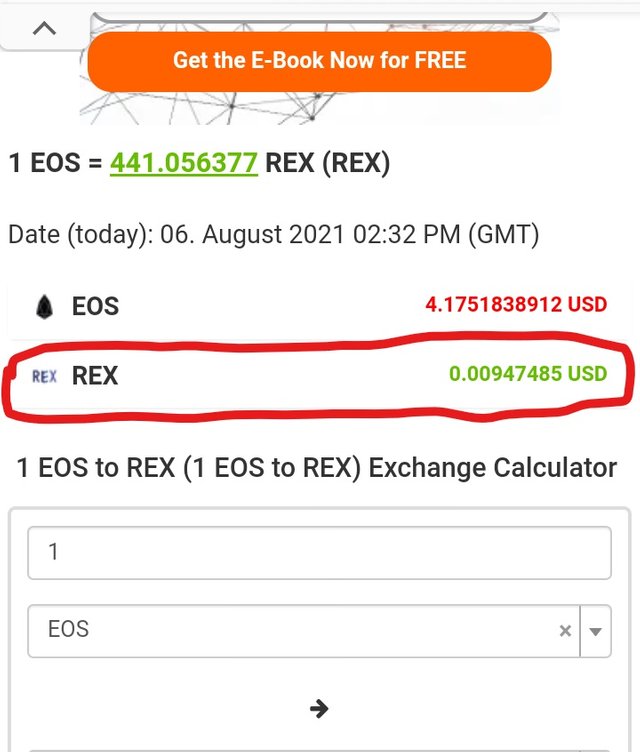 Screenshot| walletinvestor.com
Screenshot| walletinvestor.com
According to the price quoted on walletinvestor.com , REX token at the time of writing this article settled at 0.000947 USD.
REX token, which is the utility token of the Resource Exchange platform, provides an opportunity where idle TLOS can be staked and made available for those who need them. Thereby, rewarding the original owners with some form of revenue.
The Resource Exchange platform was built to facilitate the lease of idle resources - TLOS - on the EOS blockchain, and to attract rewards to the owners of the leased resources.
TLOS are staked in exchange for REX tokens; REX, in turn, allows users to rent out CPU and Net resources with rewards received back in TLOS.
Thank you for reading...